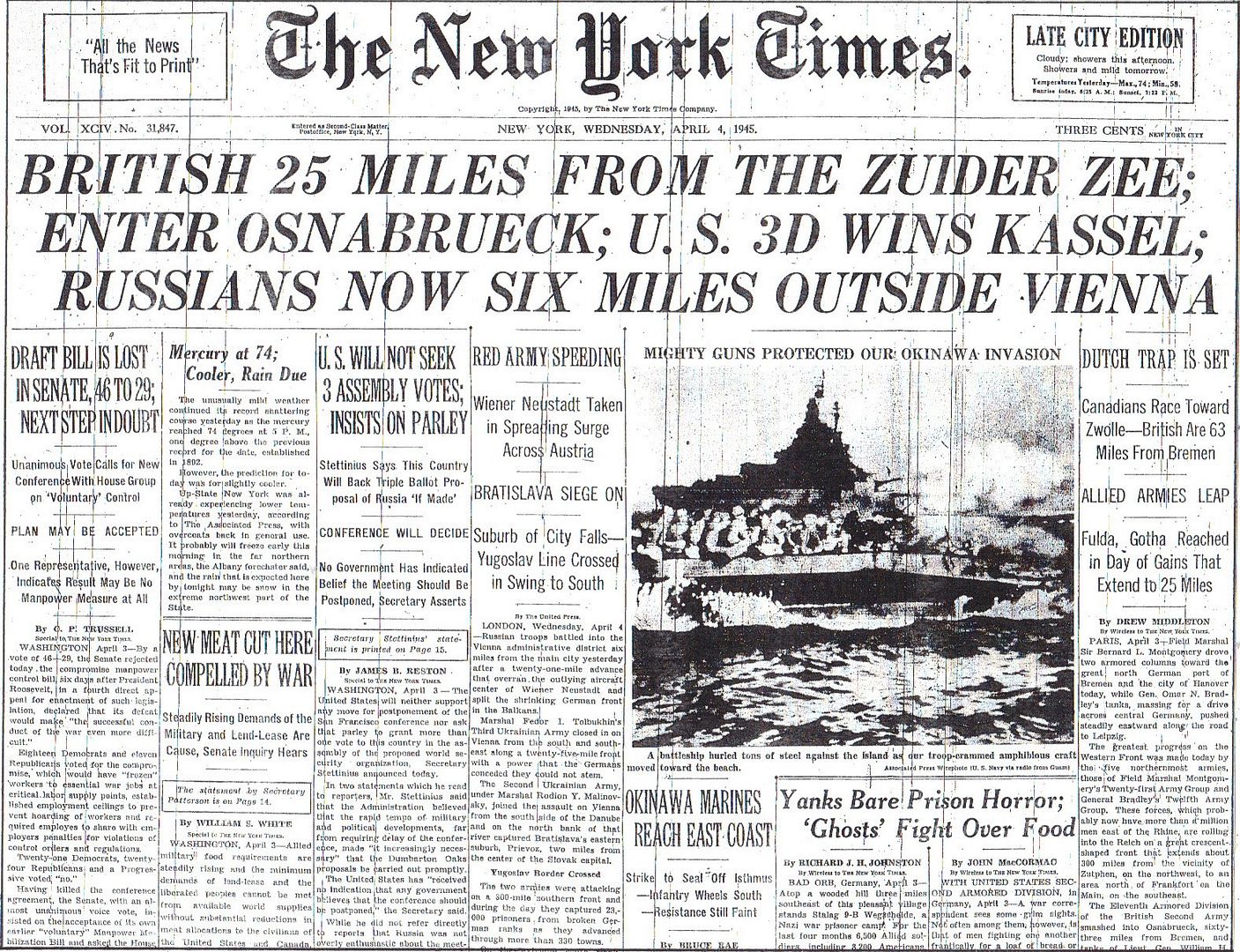
Posted on 04/04/2015 4:29:00 AM PDT by Homer_J_Simpson



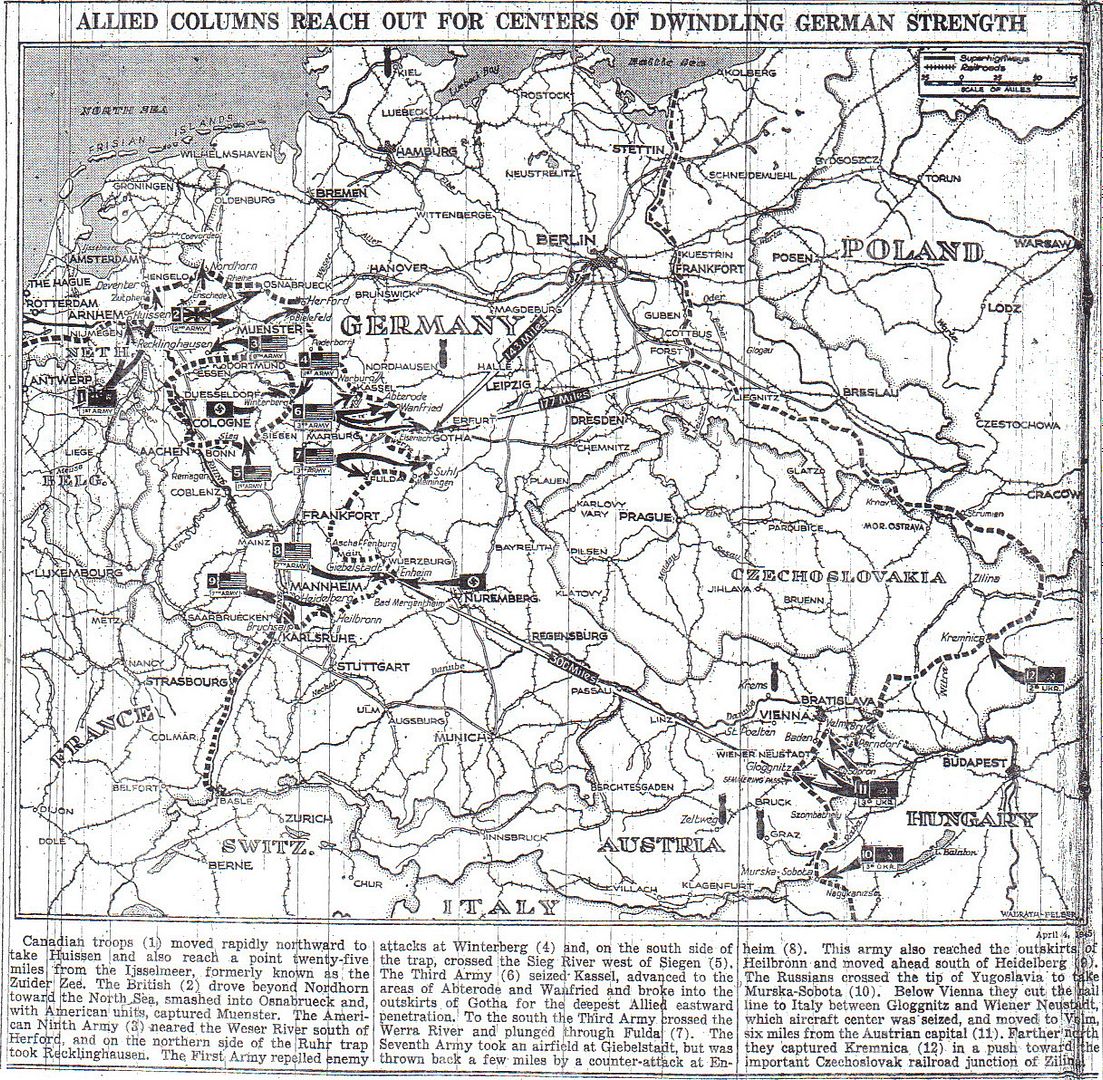
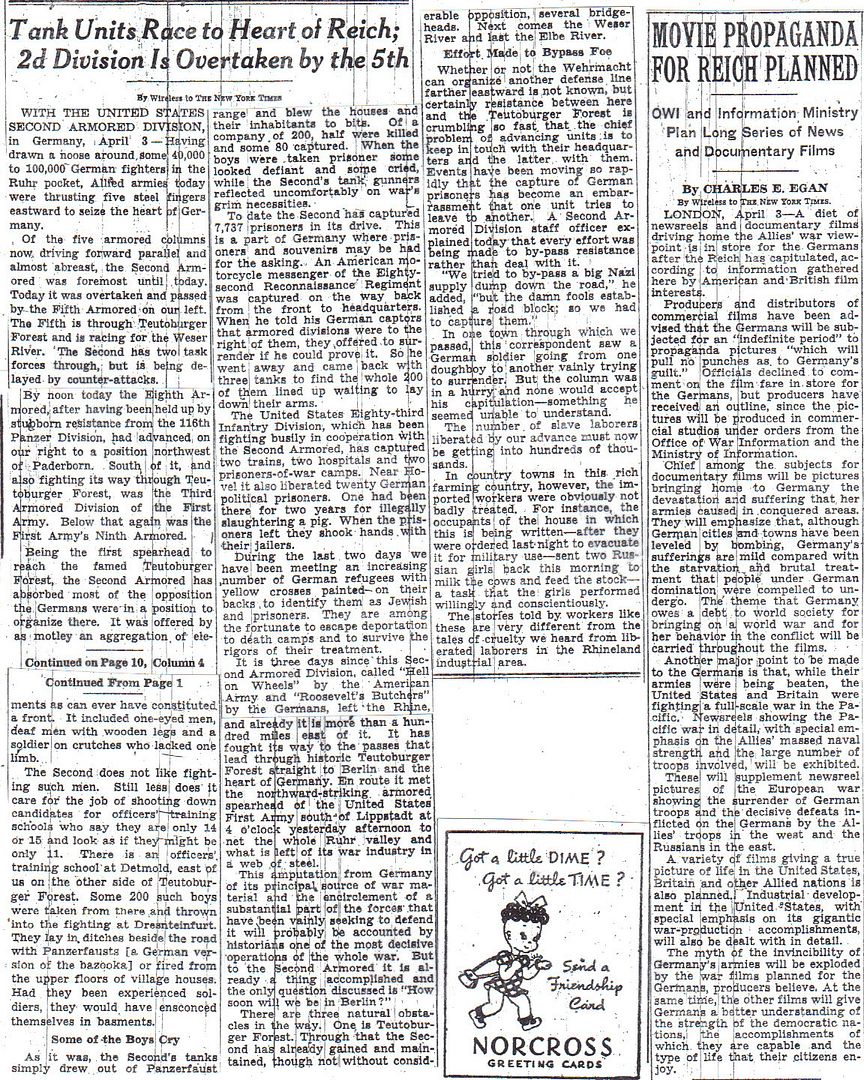
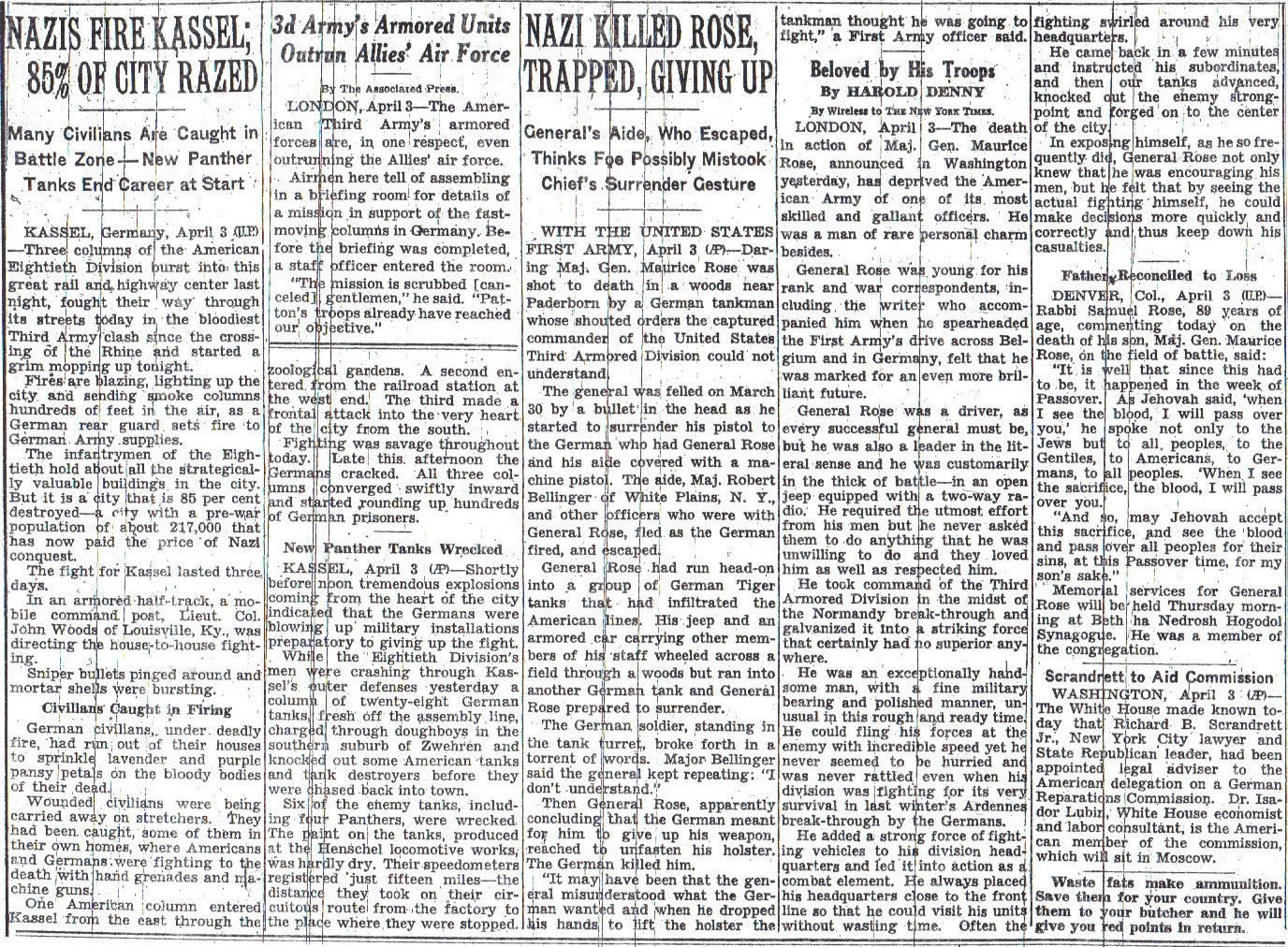
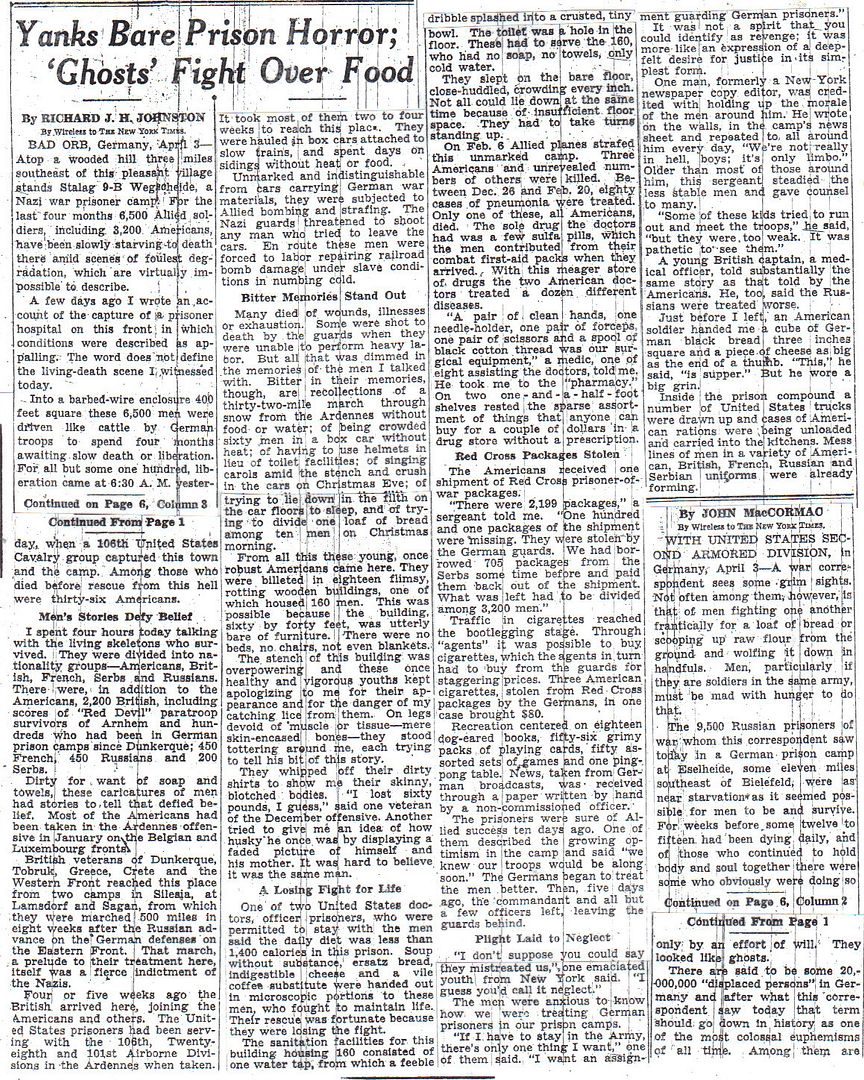

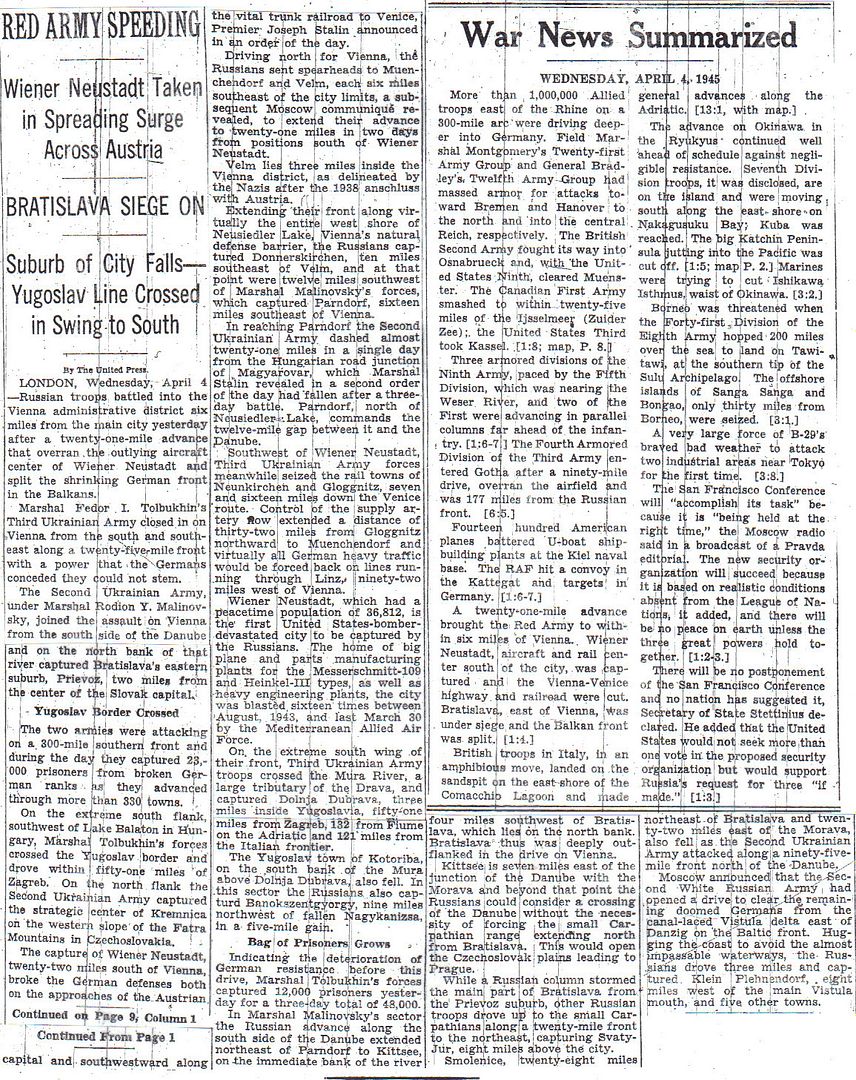
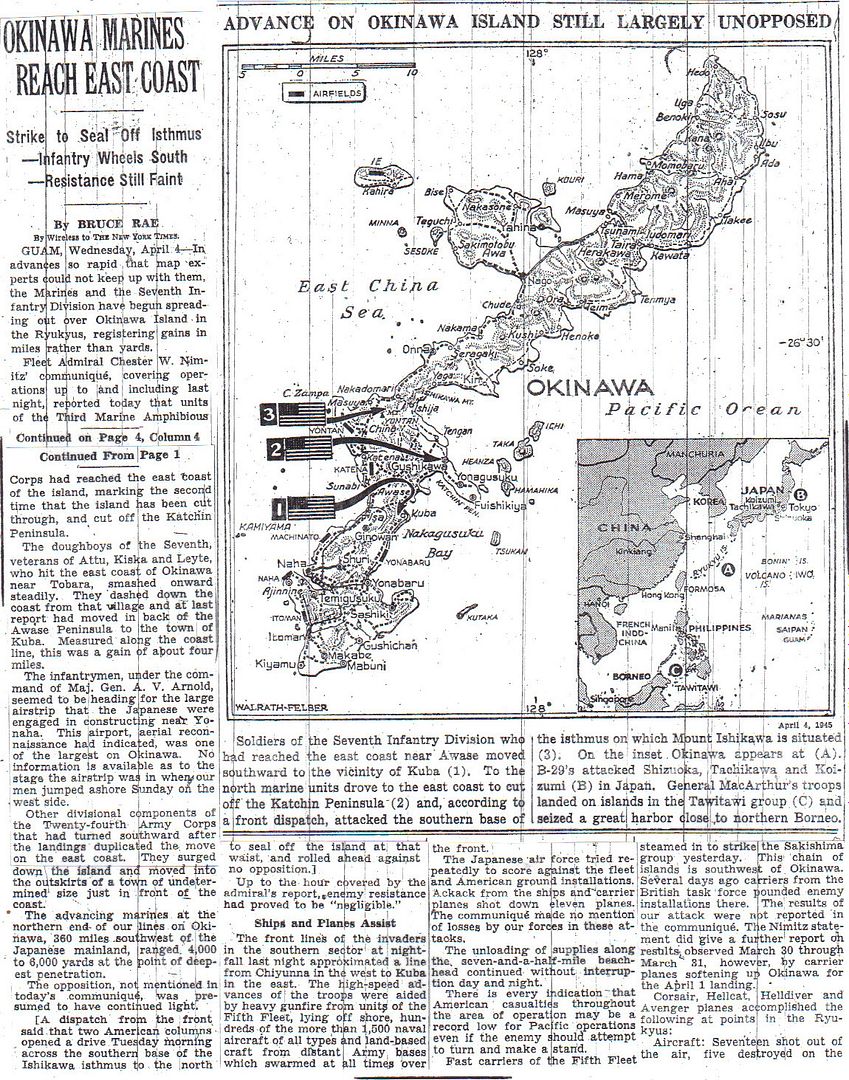
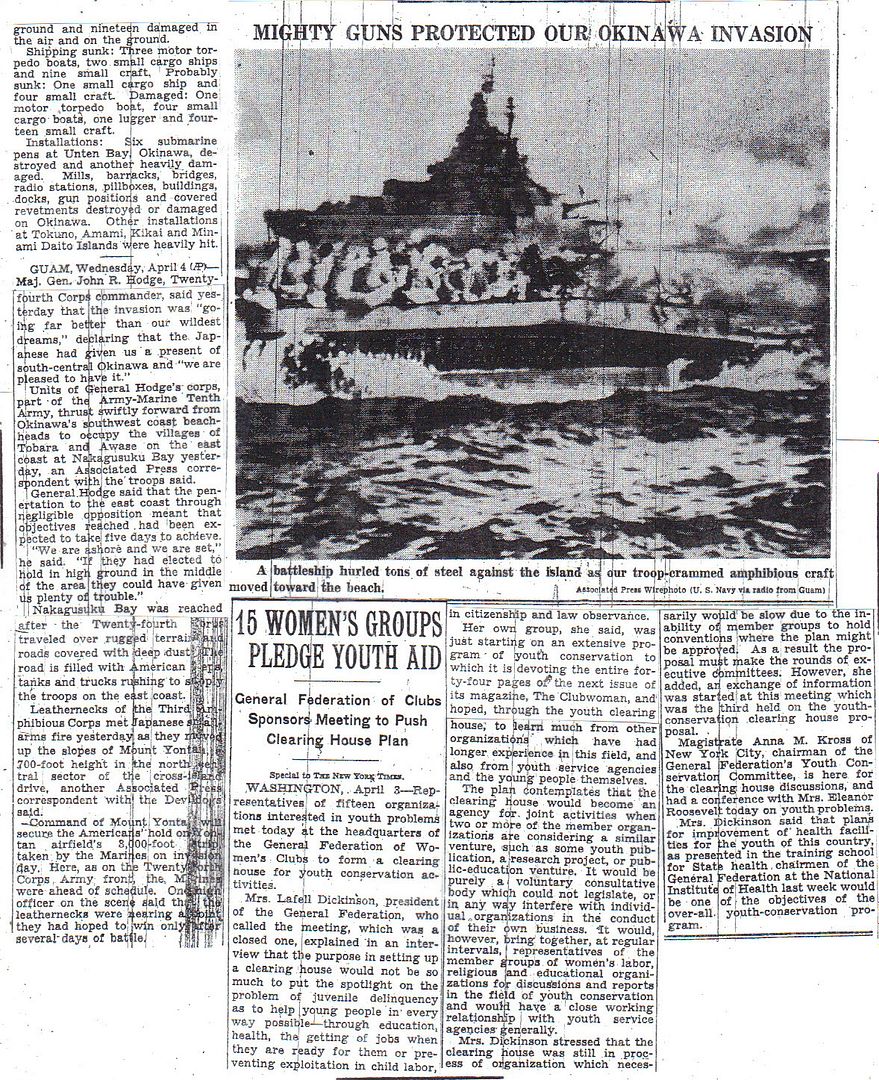
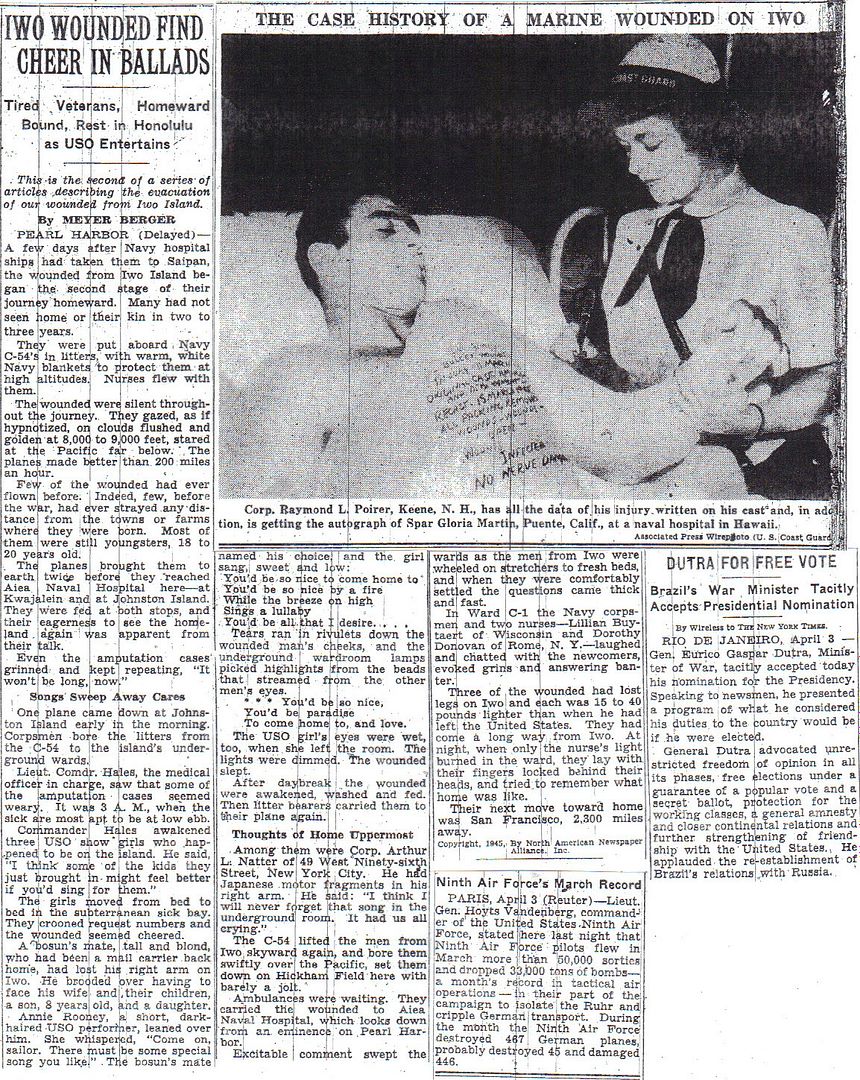
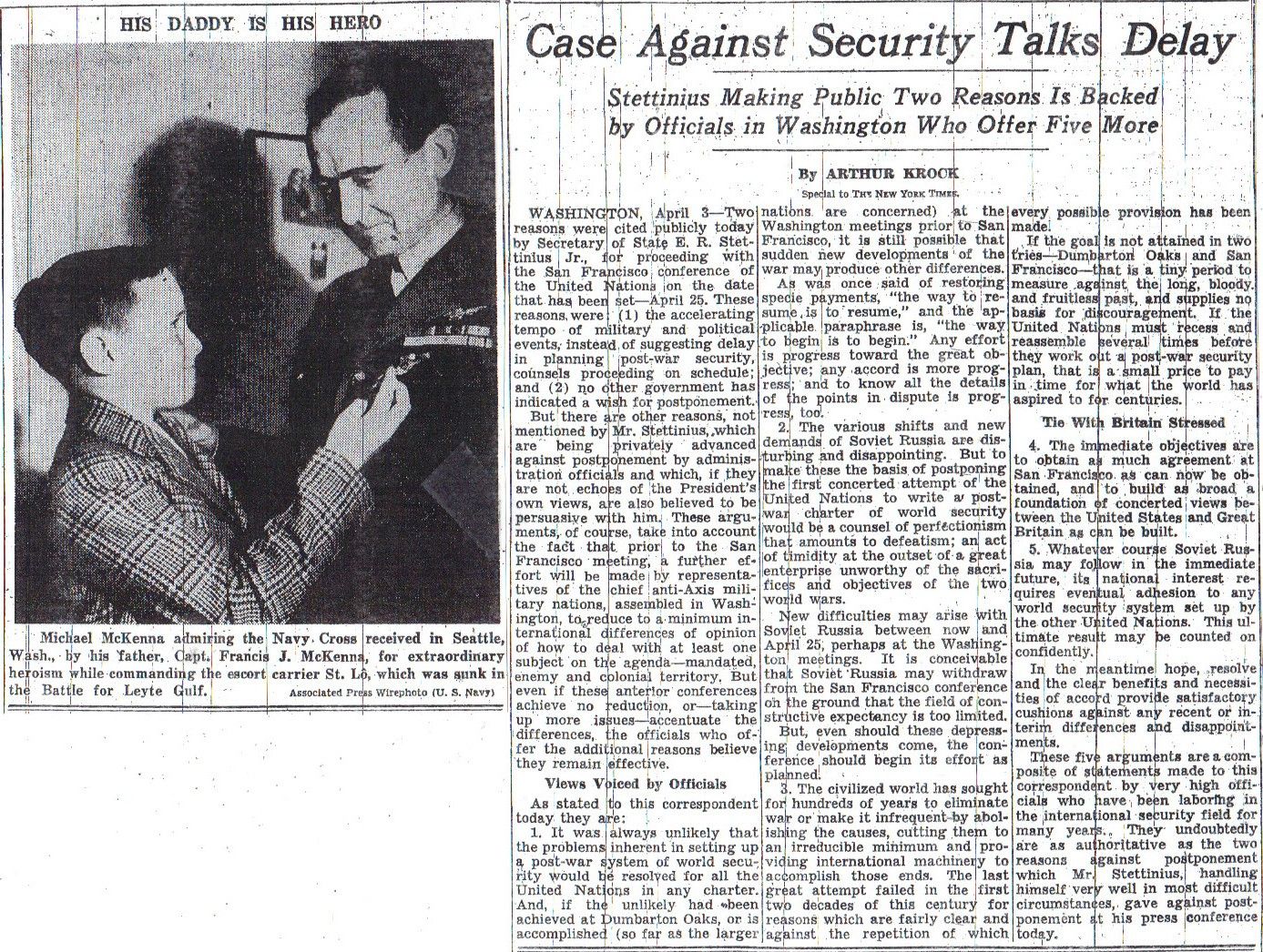
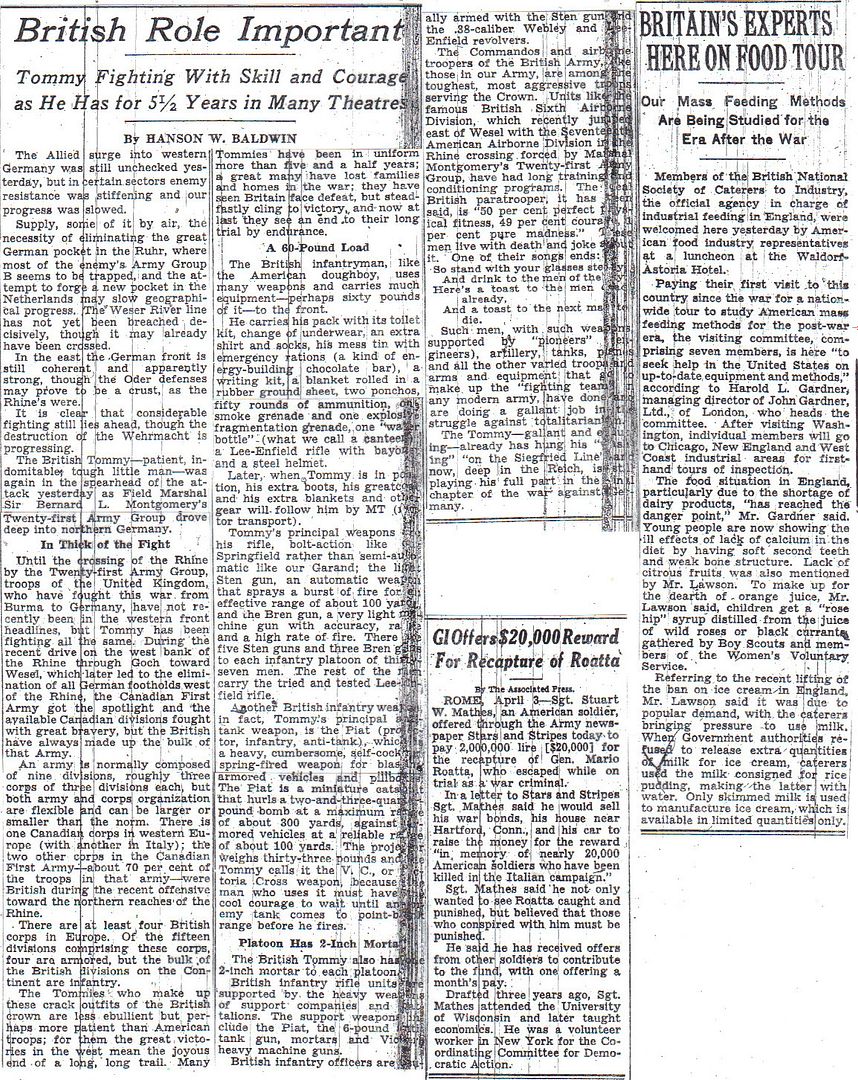
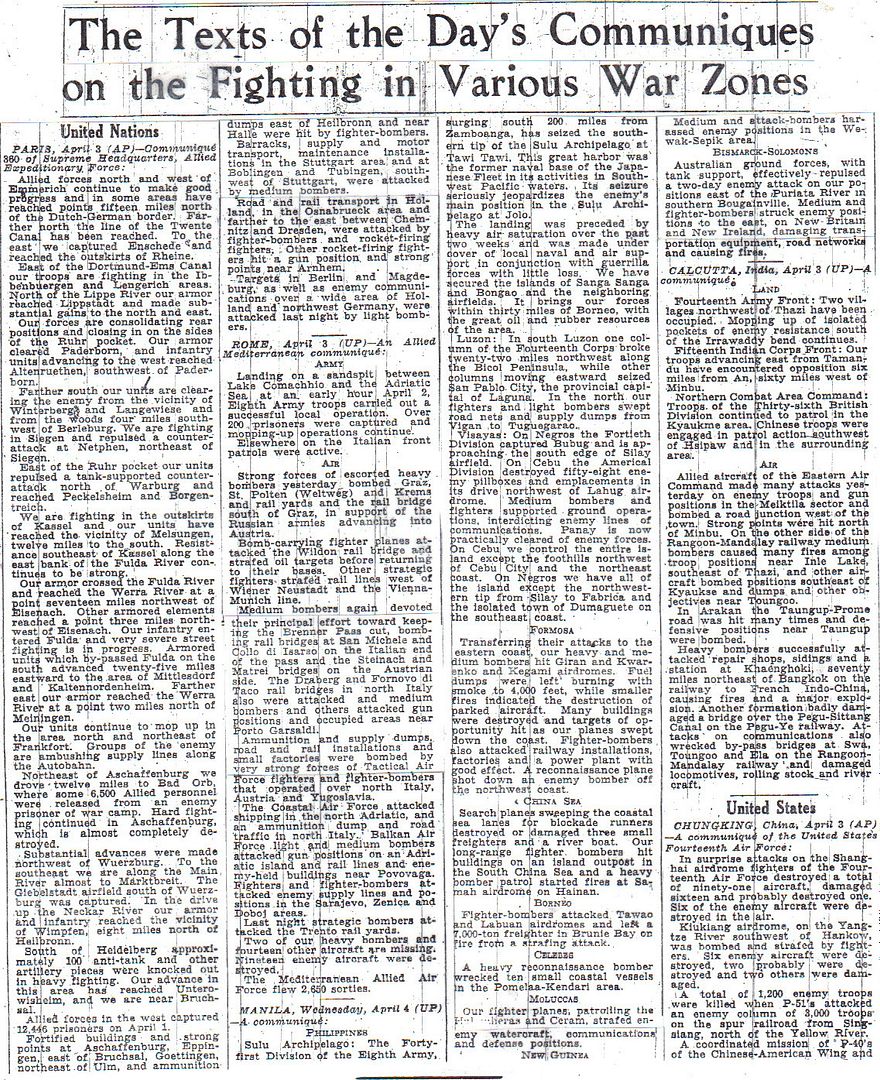
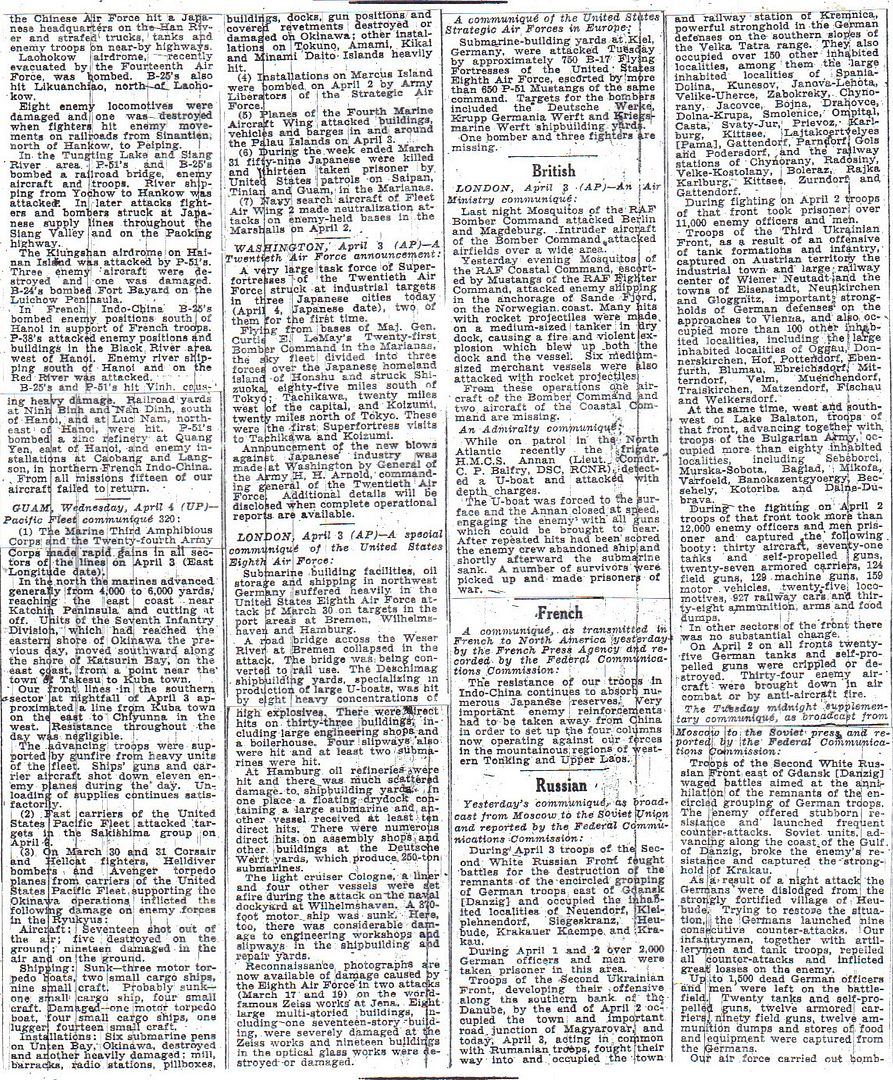
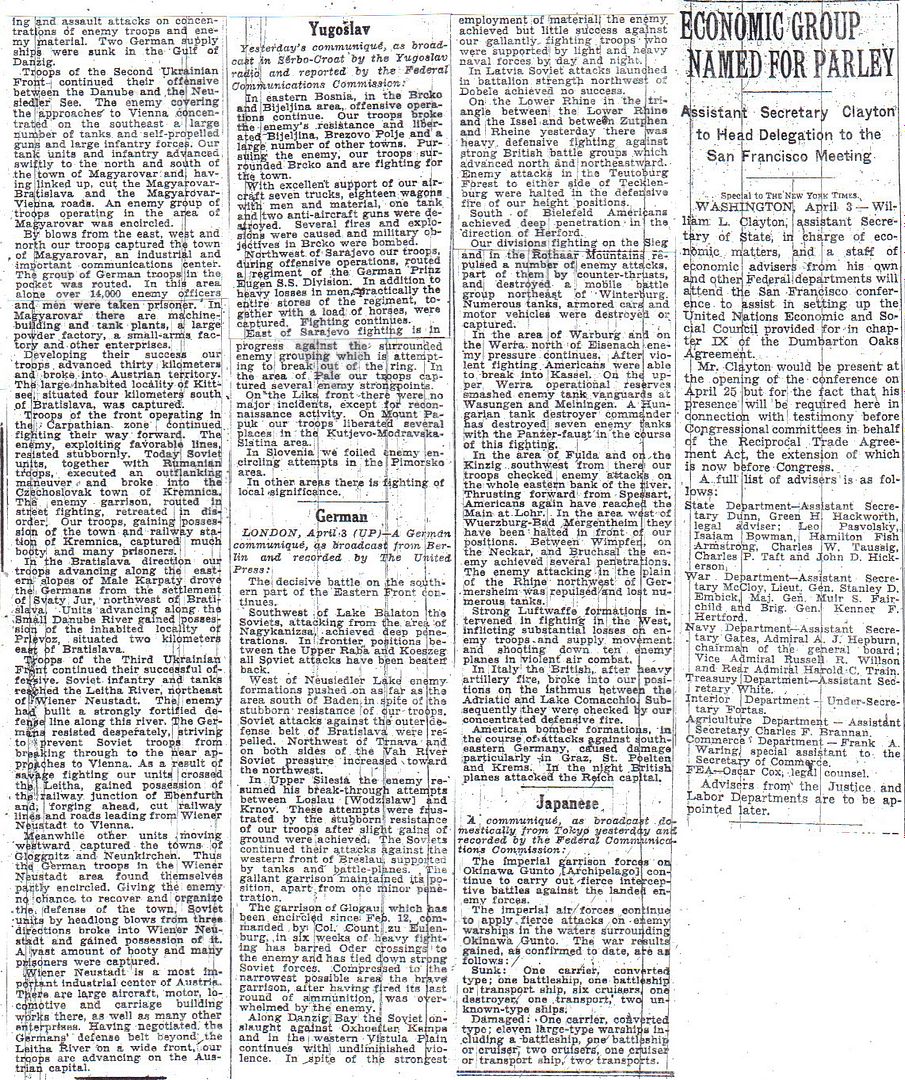
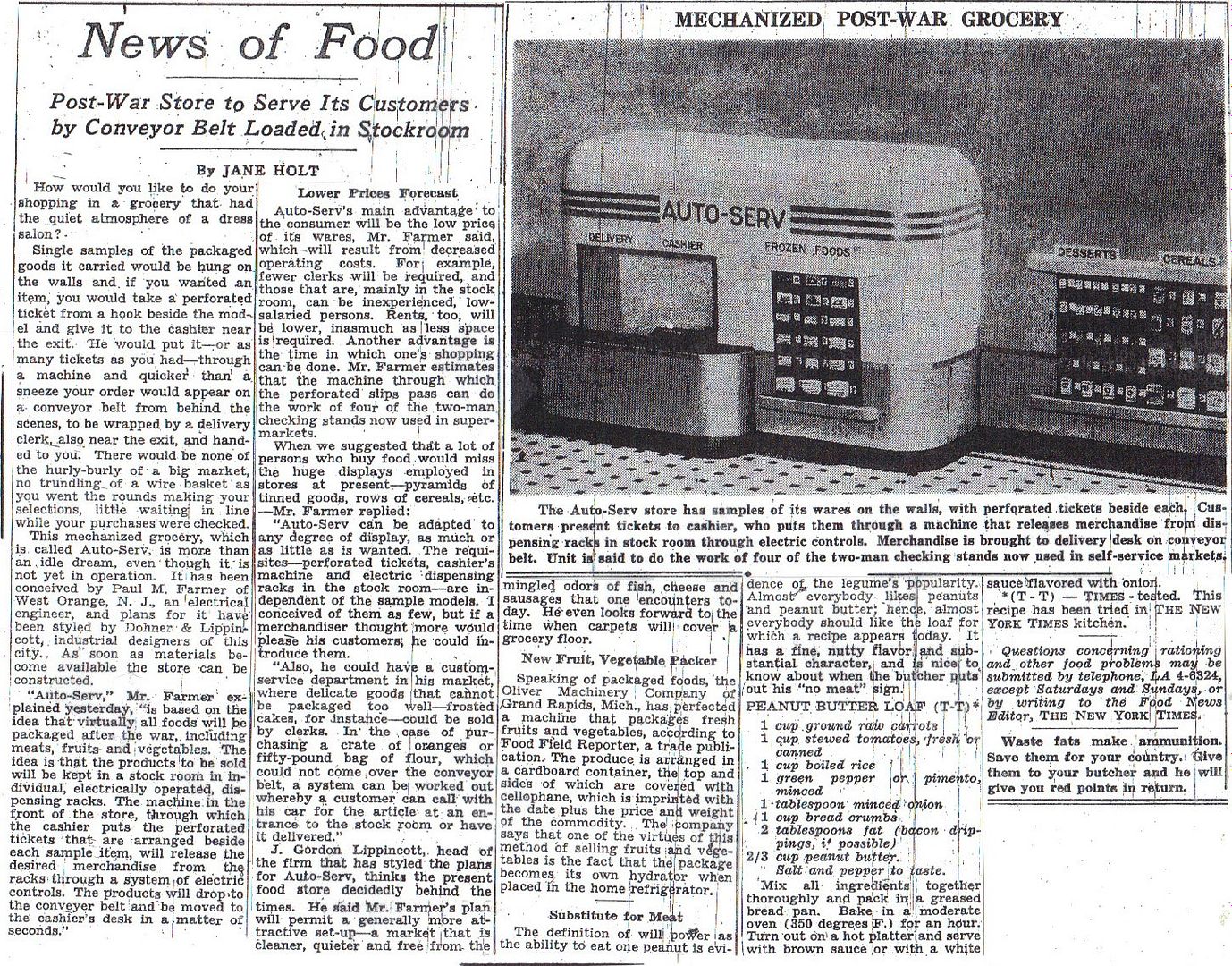
http://www.etherit.co.uk/month/3/04.htm
April 4th, 1945 (WEDNESDAY)
GERMANY: British and Canadian units take Osnabruck.
The US 9th Army reaches the River Weser at Hameln.
The US 3rd Army captures Kassel. The army also frees the slave labour camp at Ohrduf near Gotha when elements of the 4th Armored and 89th Inf. Divisions enter the slave-labour camp which is an “aussenlager” or subsidiary camp of KZ Buchenwald, near Weimar. It is the first camp to be overrun on German territory by the Western Allies. [The notorious KZ Natzweiler-Struthof in Alsace had been overrun by US forces in Nov.1944, but was previously evacuated by the SS.] (Russell Folsom)
French Units take Karlsruhe.
Gotha falls to US forces as US aircraft smash the naval bases at Kiel and Hamburg.
US Air Force Operations
GERMANY:
STRATEGIC OPERATIONS: The U.S. Eighth Air Force dispatches 1,431 bombers and 866 fighters to hit airfields, a shipyard and a U-boat shipyard in Germany; they claim 30-4-30 Luftwaffe aircraft; 10 bombers and 4 fighters are lost.
1. 438 B-24s are sent to hit Parchim (33) and Perleberg (29) Airfields; 97 hit Wesendorf Airfield, the secondary; attacks are visual; they claim 6-4-6 aircraft; 6 B-24s are lost. Escorting are 324 P-47s and P-51s; the P-47s claim 14-0-20 aircraft and the P-51s claim 9-0-3 aircraft; 1 P-47 and 3 P-51s are lost.
2. 443 B-17s are sent to hit Fassberg Airfield (149); secondary targets hit are Hoya (37) and Dedelsdorf (13) Airfields; targets of opportunity are Unterluss (39) and other (24); bombing is visual; 1 B-17 is lost, 2 damaged beyond repair and 58 damaged. The escort is 220 of 232 P-51s; 1 is lost.
3. 505 of 526 B-17s hit the Deutsche shipyard at Kiel using H2X radar; 2 others hit Eggebeck Airfield, a target of opportunity; 3 B-17s are lost and 50 damaged. The escort is 208 P-51s; none are lost.
4. 22 of 24 B-17s fly a DISNEY mission attacking the Finkenwarder U-boat yard at Hamburg without loss.
5. 19 P-51s fly a scouting mission and claim 0-0-1 aircraft.
6. 25 P-51s escort 8 F-5s and 2 P-38s on photo and radar reconnaissance missions over Germany, claiming 1-0-0 aircraft.
7. 16 P-51s escort 1 OA-10 and 2 B-17s on air-sea-rescue patrols.
TACTICAL OPERATIONS: 330+ B-26s, A-20s and A-26s hit the Ebrach oil depot, Crailsheim marshalling yard and barracks area, Grossaspach supply depot, the town of Ellswangen, Backnang rail and road junction, and 2 targets of opportunity; fighters escort the bombers, fly patrols, sweeps, and armed reconnaissance, attack special targets, and support the US 104th Infantry Division at Scherfede and Hardehausen, the 9th Armored Division in the Warburg area, the XX Corps in the Muhlhausen-Kassel areas, the 2d and 5th Armored Divisions in the Hameln and Minden areas on the Weser River, and the 8th Armored Division as it assaults the Ruhr pocket in the Lippstadt area.
HUNGARY: Bratislava falls to Soviet forces under Malinovsky.
ITALY: U.S. Twelfth Air Force B-25s continue to blast communications along the Brenner rail line, ranging from the railroad bridge at Drauburg to the Camposanto railroad bridge; the B-25s also inflict considerable damage on the Merano methanol plant; P-47s concentrate on enemy movement, rail lines, and ammunition and fuel dumps throughout the Po Valley.
BURMA: Combat operations by the Tenth Air Force are restricted to attacks on a troop concentration and rice and fuel supplies behind enemy lines in central Burma; transports operate on steady basis throughout the day.
CHINA: U.S. Far East Air Force B-24s bomb Toyohara Airfield, Mako harbour, and Tokichito Island and A-20s hit Shinchiku factories and rail yards on Formosa. B-24s bomb the harbour at Hong Kong.
FORMOSA: Far East Air Force B-24s bomb Toyohara Airfield, Mako harbour, and Tokichito Island and A-20s hit Shinchiku factories and rail yards.
JAPAN: A Japanese escort vessel and a merchant cargo ship are sunk by mine laid by B-29s.
MARIANAS: 2 B-29s bomb groups arrive at West Field, Tinian Island from India.
OKINAWA: The high speed transport USS Dickerson (APD-21), irreparably damaged by kamikaze on 2 April 1945, is towed out to sea and scuttled. Kamikazes damage the destroyer USS Wilson (DD-408) off southern end of Kerama Retto and the destroyer USS Sproston (DD-577) is damaged by near-miss by bomb.
The first real resistance is met by Hodges troops on Okinawa. They are halted on a line just south of Kuba.
The landing craft of TF 51 off Okinawa suffer damage from heavy weather.
COMMONWEALTH OF THE PHILIPPINES: U.S. Far East Air Force P-38s and P-51s pound various targets in central Luzon Island while A-20s and P-38s hit the Calauag area. A-20s pound northwest Negros Island and B-24s bomb targets on central Mindanao Island.
U.S.A.: The Joint Chiefs of Staff (JCS) designates General of the Army Douglas MacArthur”> MacArthur Commander-in-Chief, US Army Forces, Pacific (CINCUSAFPAC) and Fleet Admiral Chester W Nimitz Commander-in-Chief, Pacific (CINCPOA).
Is it just me or is page 10 invisible?
Now it is back. Very mysterious.
"The Allied High Command was interested in what had occurred in the camps, and officers regularly toured them to gain information regarding Nazi crimes.
Here, Generals George Patton, Omar Bradley, and Dwight Eisenhower (left to right) visit the Ohrdruf, Germany, camp--the first camp liberated by the Americans--on April 4, 1945.
A former prisoner demonstrates SS torture techniques for them."
"The SS shot these Polish inmates in a mass execution at Ohrdruf, Germany.
As so often happened, the Germans killed their prisoners rather than see them fall into the hands of the Allies.
American General Omar Bradley said of the atrocities at Ohrdruf: 'The smell of death overwhelmed us even before we passed through the stockade.
More than 3,200 naked, emaciated bodies had been flung into shallow graves.
Others lay in the streets where they had fallen.
Lice crawled over the yellowed skin of their sharp, bony frames.' "
"The labor camp Ohrdruf, near Gotha, Germany, occupies a distinct place in history.
The first camp liberated by the Western Allies, Ohrdruf provided American troops with proof of Nazi barbarity.
"At Ohrdruf, thousands of slave laborers had worked frantically under brutal conditions to prepare an underground communications center for the German Army.
On April 4, 1945, American soldiers entering Ohrdruf (pictured) found mass graves containing thousands of corpses.
Some prisoners had been executed and hastily buried only four days before the Americans entered the camp.
The troops also encountered a few living witnesses, men who had escaped from the camp shortly before the Nazis began shooting the remaining prisoners.
"Eight days after the camp was liberated, U.S. Generals Dwight Eisenhower, Omar Bradley, and George Patton, men deeply familiar with the mayhem of war, visited the camp.
An angered Eisenhower encouraged the press to tour the camp and inform the world of the atrocities committed there."
Throughout the Pacific war we’ve seen quite a bit of reference to Ulithi atoll, with its gigantic anchorage that was so important to the U.S. Navy.
If my understanding is correct, that name and location was kept secret during the war, and once better harbors were obtained in the Philippines and elsewhere I think Ulithi fell into disuse and back into obscurity, where I think it has pretty much remained. I can’t recall ever hearing anything about it in the modern sense.
So imagine my surprise this morning when I actually saw a reference to it in the latest news!
Typhoon Maysak Flattens Ulithi Villages
Germans surrender Kassell
http://en.wikipedia.org/wiki/Battle_of_Kassel_%281945%29
Fighting in Kassel was house-to-house from April 2, but the German defenders were too few to defend effectively and the U.S. forces pushed into the city’s center, fending off local counter-attacks by infantry and tanks. American tanks and the U.S. 319th Infantry were meanwhile approaching Kassel from the east bank of the Fulda River. The U.S. 317th Infantry was guarding the Americans’ flank in the west and the U.S. 318th Infantry pushed through the city, arriving in the vicinity of the command bunker of General Erxleben at 0900 on April 4, 1945. Faced with the collapse of his defenses, Erxleben dispatched a captain early on April 4 to discuss surrender terms with the Americans. The American reply was that the Germans had to cease resistance with no cease-fire to evacuate wounded or civilians, or that the fighting would continue. Around 1100 on April 4, U.S. tanks crossed the Fulda River from the east and moved toward the center of Kassel. At 1200, General Erxleben capitulated and was taken prisoner along with 1,325 others, effectively ending the Battle of Kassel.
http://marshallfoundation.org/library/digital-archive/to-general-of-the-army-douglas-macarthur-6/
General George C. Marshall To General of the Army Douglas MacArthur, April 4, 1945
1945
Publisher: The Johns Hopkins University Press
Date: April 4, 1945
Subject: World War II
Collection: Papers of George Catlett Marshall, Volume 5: The Finest Soldier
Summary
To General of the Army Douglas MacArthur
April 4, 1945 Radio No. WAR-63196. Washington, D.C.
Top Secret
TOPSEC to General MacArthur for his eyes only from General Marshall.
A directive from the Joint Chiefs of Staff reorganizing the Command set-up in the Pacific Theater is being dispatched. This solution to the problem has been reached after prolonged and exceedingly difficult discussion.1 The final document has, however, been amicably agreed upon. It constitutes a major retreat by the Navy from their original stand. It has been necessary for us to make minor concessions in order to secure agreement on the major matters. Throughout, Admiral King continually expressed fears that the change in the command arrangements and the reorganization brought about by the directive would initially retard operations against the Japanese rather than add to the impetus now under way and might result in disruption and duplication in our logistics. I have assured him that such was not the case but for a time it appeared that it would be necessary to amplify the directive by means of JCS minutes designed to allay these fears. Fortunately, we were able to arrive at agreement without resort to any qualifying minutes. I have felt that you and Nimitz could work out most of the details harmoniously and that close coordination between your Headquarters and the War Department would prevent difficulties from arising.
The reorganization must necessarily be effected progressively and in such a manner as not to interfere with the impetus of operations or to provide any basis for assertions that the changes insisted upon by the Army have at least temporarily slowed down the war in the Pacific.2
You may be in need of additional high caliber officers due to the greatly increased burden of responsibilities, particularly logistical, falling to you under the new organization. If you do not have available all of such personnel you require I will endeavor to find them for you. Would you care for a man of the caliber of General Styer, Somervell’s Deputy and Chief of Staff, or Lutes, his number 2 man, to head up your supply and logistics?3 We can furnish you some additional planners if you have need for them. Topnotch personnel remaining in the United States at the moment is somewhat limited but if there are any officers in particular you would like to have, send in their names and we will try to make them available. As soon as the war in Europe ends we can give you almost anyone or anything you want.
In the first phases of this reorganization we will have an extremely delicate problem in handling jealousies arising between the services and difficult personalities in various posts. There has been a great deal of most unfortunate rumor and talk in this country, which has made the War Department task in reaching a satisfactory agreement most difficult. I sincerely hope we can raise the level of cooperation above the personal basis and that of trivial rumor, to one of sound procedure respected by all. Please do your best to suppress such critical comments in subordinate echelons and I will do the same here with a heavy hand.
You will soon be formally called upon for an expression of your views as to the character of the campaign leading up to the actual invasion of Japan. At the moment the Navy, not necessarily Nimitz, appear to favor a gradual encirclement or siege approach including operations on or off the coast of China and even possibly extending north to islands west of Kyushu.
As soon as the directives are formally issued you will be designated Commander-in-Chief of the Army Forces in the Pacific Theater.4
Document Copy Text Source: George C. Marshall Papers, Pentagon Office Collection, Selected Materials, George C. Marshall Research Library, Lexington, Virginia.
Document Format: Typed radio message.
1. J.C.S. 1259/4 issued on April 3 was sent to MacArthur, Nimitz, and Arnold in Radio No. WARX-62773. The directive designated General MacArthur commander in chief, U.S. Army Forces, Pacific (CINCAFPAC), and placed all U.S. Army resources there under his command, except those in the southeast Pacific and Alaska. “CINCAFPAC will be responsible for the provision of army resources to meet the requirements for operations in the Pacific directed by the Joint Chiefs of Staff.” Likewise, all naval resources were placed under Admiral Nimitz as commander in chief, Pacific Fleet (CINCPAC). (Joint Chiefs of Staff Command and Operational Directives for the Pacific [J.C.S. 1259/4], April 3, 1945, NA/RG 165 [ABC, 323.31 POA, Section 3-A [1-29-42]. Joint Chiefs of Staff to MacArthur, Nimitz, and Arnold, Radio No. WARX-62773, April 3, 1945, NA/RG 165 [OPD, 384 TS, Case 1].) For previous information regarding the Pacific command discussions, see Marshall Memorandum for General Hull, March 19, 1945, Papers of George Catlett Marshall, #5-065 [5: 91-92], and Marshall Memorandum for Admiral King, March 22, 1945, #5-067 [5: 94-97].
2. The J.C.S. directive provided that “until passed to other command by mutual agreement or by direction of the Joint Chiefs of Staff, the localities under command of CINCSWPA and the Naval Forces allocated to him will remain under his command and similarly, the areas under command of CINCPOA and the Army Forces allocated to him will remain under his command. Changes in command of forces or localities and changes made in existing Joint logistical procedures will be effected by progressive rearrangements made by mutual agreement, or as may be directed by the Joint Chiefs of Staff.” (Joint Chiefs of Staff Command and Operational Directives for the Pacific [J.C.S. 1259/4], April 3, 1945, NA/RG 165 [ABC, 323.31 POA, Section 3-A (1-29-42)].)
3. Lieutenant General Wilhelm D. Styer assumed command of U.S. Army Forces in the Western Pacific (AFWESPAC) with headquarters at Manila in June 1945. Major General LeRoy Lutes had served with the Army Service Forces since January 1943.
4. “My heartiest congratulations on your great success in reorganizing the Pacific Command,” replied MacArthur. “To have accomplished as much as you did amicably is a masterly performance. This represents an outstanding contribution not only to the Army, but to the country. You may be confident of complete support from this Command. I do not anticipate any difficulties in achieving complete and harmonious cooperation with Admiral Nimitz.” (MacArthur to Marshall, Radio No. CA-51389, April 5, 1945, GCMRL/G. C. Marshall Papers [Pentagon Office, Selected].) For the chief of staff’s reply, see Marshall to MacArthur, April 6, 1945, Papers of George Catlett Marshall, #5-092 [5: 133-34].
Recommended Citation: ThePapers of George Catlett Marshall, ed.Larry I. Bland and Sharon Ritenour Stevens(Lexington, Va.: The George C. Marshall Foundation, 1981- ). Electronic version based on The Papers of George Catlett Marshall, vol. 5, “The Finest Soldier,” January 1, 1945-January 7, 1947 (Baltimore and London: The Johns Hopkins University Press, 2003), pp. 117-118.
Digital Downloads
5-085.doc
Collection
Papers of George Catlett Marshall, Volume 5: The Finest Soldier
Japanese Suicide Rocket Bomb Plane, Yokosuka MXY7 Ohka, Okinawa, 04/04/1945
https://archive.org/details/ADC-3810b
Fascinating footage. They’re virtually field-stripping the thing as we watch.

B-25 Mitchell, nicknamed “Ruthless Ruth”, pulls up after making a skip-bombing run on Japanese coastal defense vessel No. 134. The plane was flown by USAAF Lieutenant Louie A. Mikell of the 499th Bomb Squadron (“Bats Outa Hell”), part of 5th Air Force. Japanese convoy HOMO-03 left Hong Kong enroute to Shanghai, consisting of subchasers CH-9 and CH-20, destroyer Amatsukaze, Kaibokan (escort destroyers) Coastal Defense Vessels No. 1 and No. 134, Tokai Maru Number 2 and Kine Maru on April 4, 1945.
Attacks by US Air Force B-24 Liberators on April 5 sink the two transports, and the convoy breaks up. The subchasers return to Hong Kong while the destroyers head for Amoy, China. Enroute, CH-9, CH-20 and No. 1 are damaged by another wave of B-24s. The next day, the three destroyers are found by twenty-four B-25s of the 345th; the Americans volunteered for the long over-water flight from their base at San Marcelino, Luzon to the Japanese ships off the China coast. Lt. Mikell scored a near-miss with his delayed fuse bomb; Lieutenant Francis Thompson strafed the ship; the flight leader scored a hit amidships. No. 134 rolled over to starboard and sank, her surviving crew abandoning ship to the shark-infested waters. No. 1 was also skip-bombed and sank. Amatsukaze destroyer was also heavy damaged. Her crew beached the ship a mile away on a reef, at the entrance to Amoy harbor, but slipped stern-first into the sea and sank with the loss of 44 of her crew.
The tactic used in these attacks is called skip-bombing. Skip bombing is a low-altitude bombing attack that has been successfully used against naval targets. It consists of a string of from two to four bombs dropped from such an altitude and distance from the target that a complete miss is improbable. The attack should be delivered with the idea in mind of securing a maximum of surprise and should not be repeated against the same targets too often. The altitude of the attack should be from 200 to 300 feet (60-90 meters) and the bomb-release line from 350 to 200 feet (60-100 meter) from the target. Skip bombing was very effective but also potentially suicidal if the target was on high alert and equipped with good AA guns and directors.
Interesting stuff:
In the last frame, you can see a lot of men in the water, or working their way down the port side of the hull. Sources say that 44 of her crew of 240 died in this attack. The ship in the photo is a Kaikoban type C diesel engined escort ship. The C Type escorts were used for convoy escort operations. However by 1944 the advantage had passed to the US, and many C Type vessels became casualties as the Japanese merchant fleet was devastated by the American submarine offensive. There were 53 finished during the war of the 300 planned, and several completed after World War II ended. 26 were sunk during the war.
(Photo taken six miles South-Southwest of Amo, Fujian, China. Archive: United States Air Force)
http://rarehistoricalphotos.com/b-25-skip-bombs-japanese-kaibokan-escort-ship-1945/
Nazi Gold: The Merkers Mine Treasure
“Just before noon on April 4, the village of Merkers fell to the Third Battalion of the 358th Infantry Regiment, Ninetieth Infantry Division, Third Army. During that day and the next the Ninetieth Infantry Division, with its command post at Keiselbach, consolidated its holdings in the Merkers area.”
Read the amazing story of what happened after that...
http://www.archives.gov/publications/prologue/1999/spring/nazi-gold-merkers-mine-treasure.html
http://www.jewishgen.org/ForgottenCamps/Witnesses/NickolsEng.html
April 4, 1945
REPORT ON SURRENDER OF THE GERMAN CONCENTRATION CAMP AT OHRDRUF:
The date was April 4, 1945 and I was on a patrol as a member of the I & R platoon attached to the Headquarters company of 354th Infantry Regiment, of the 89th Infantry Division, 3rd Army U.S.A.
As I recall it was a beautiful spring morning marred by the fact that we were under mortar attack. I remember very well my surprise when I observed Brigadier General Robertson strolling upright down the road. He was an elderly avunular gentleman who thought nonchalance under fire characterized the general officer’s role model.
I was impressed but remained prone in the drainage ditch until the atttack ceased. Shortly thereafter, an acquaintance let it be known that a camp had been liberated further up the hill.
Fifty years have passed since this day but I recall my first impression of the camp called Ohrdruf which I found later was associated administratively with the camp called Buchenwald. Ohrdruf was named after the town of the same name, apparently locally famous for its history of being the place where Johann Sebastian Bach composed some of his works.
From the outside, the camp was unremarkable. It was surrounded by a high barbed wire fence and had a wooden sign which read, “Arbeit Macht Frei.” The swinging gate was open, and a young soldier, probably an SS guard, lay dead diagonally across the entrance. The camp was located in the forest and was surrounded by a thick grove of pine and other conifers. The inside of the camp was composed of a large 100 yards square central area which was surrounded by one story barracks painted green which appeared to house 60-100 inmates.
As we stepped into the compound one was greeted by an overpowering odor of quick-lime, dirty clothing, feces, and urine. Laying in the center of the square were 60-70 dead prisoners clad in striped clothing and in disarray. They had reportedly been machine gunned the day before because they were too weak to march to another camp. The idea was for the SS and the prisoners to avoid the approaching U.S. Army and the Russians.
Adjacent to the “parade ground” was a small shed which was open on one side. Inside, were bodies stacked in alternate directions as one would stack cord wood, and each layer was covered with a sprinkling of quick-lime. I did not see him, but someone told me that there had been a body of a dead American aviator in the shed. This place reportedly had been used for punishment, and the inmates were beaten on their back and heads with a shovel. My understanding is that all died following this abuse.
I visited some of the surrounding barracks and found live inmates who had hidden during the massacre. They were astounded and appeared to be struggling to understand what was happening. Some were in their 5 tier bunks and some were wandering about.
This was the first camp to be “liberated” by the Allied armies in Germany. Orhdruf was visited by Generals Eisenhower, Patton and Bradley and there are photographs of them observing the bodies of the machine gunned inmates. According to Eisenhower, Patton had refused to visit the punishment shed as he feared he would become ill. He did vomit at a later time.
Further into the camp was evidence of an attempt to exhume and burn large numbers of bodies. There was a gallows, although I really cannot remember whether I saw it or not. I don’t remember leaving the camp. I recall being numb after seeing the camp. I had just turned 20 years old and I had read the biographical “Out of the Night.” It was a pale and inadequate picture of a German concentration camp by a refugee German author.
I recall becoming very upset when we got back to our quarters, but the whole experience was far beyond my understanding. I wrote a letter to my parents describing the experience which was read at a local gathering of business men. It was widely disbelieved.
Bruce Nickols
German Tanks destroyed with paint still wet and 15 miles on the odometer.
GI OFFERS $20,000 REWARD
On 5 March 1945, Roatta escaped from the Virgilio Army Hospital in Rome.[37] An award of one million lire ($10,000) was offered for his capture.[38] The following day a “mild mass meeting” took place at the Italian royal palace in protest of his escape and escalated into a riot ending with one person dead.[39] On 4 April Sergeant Stuart W. Mathes put up a personal reward of $20,000 for Roatta’s capture.[40]
Beginning in 1964, he wrote a number of books that were published and he lived in Rome until his death on 7 January 1968.[41][42]
http://en.wikipedia.org/wiki/Mario_Roatta
Disclaimer: Opinions posted on Free Republic are those of the individual posters and do not necessarily represent the opinion of Free Republic or its management. All materials posted herein are protected by copyright law and the exemption for fair use of copyrighted works.